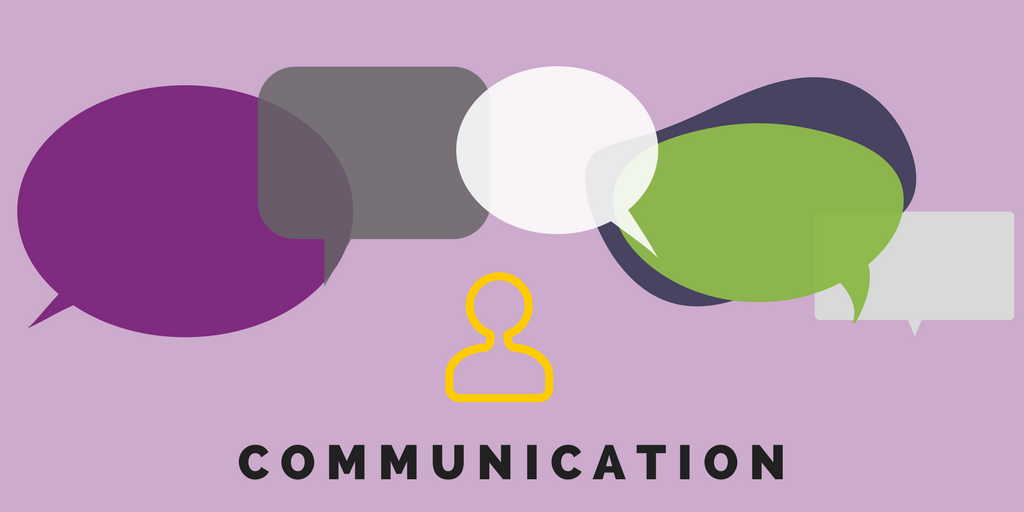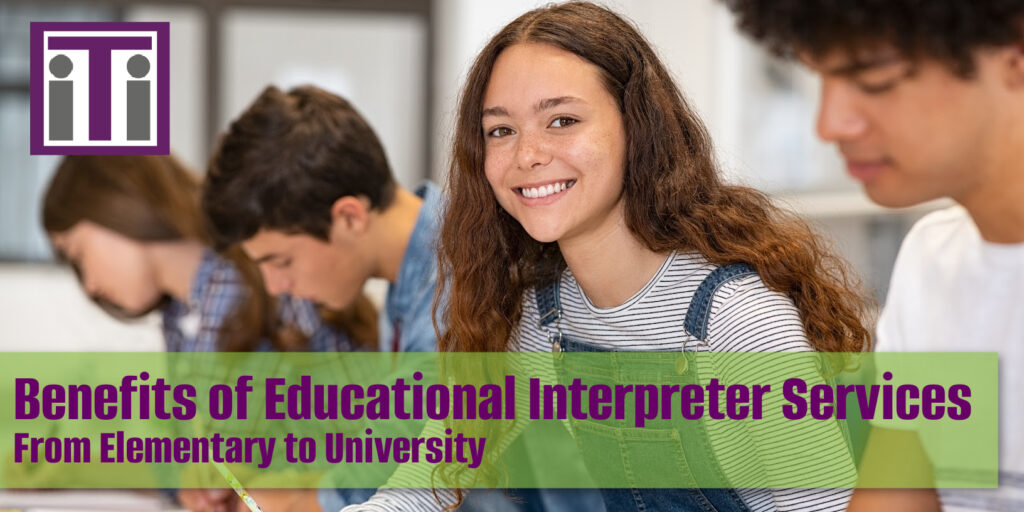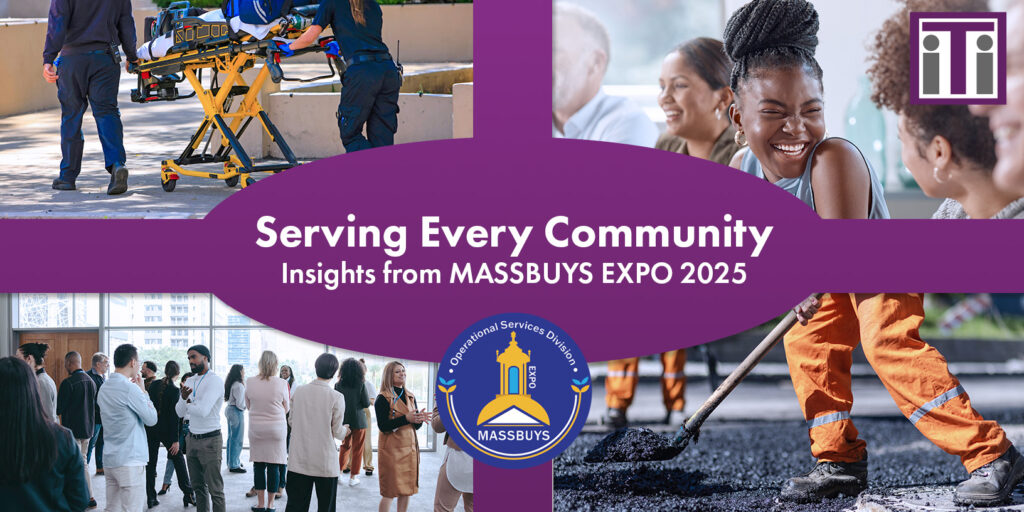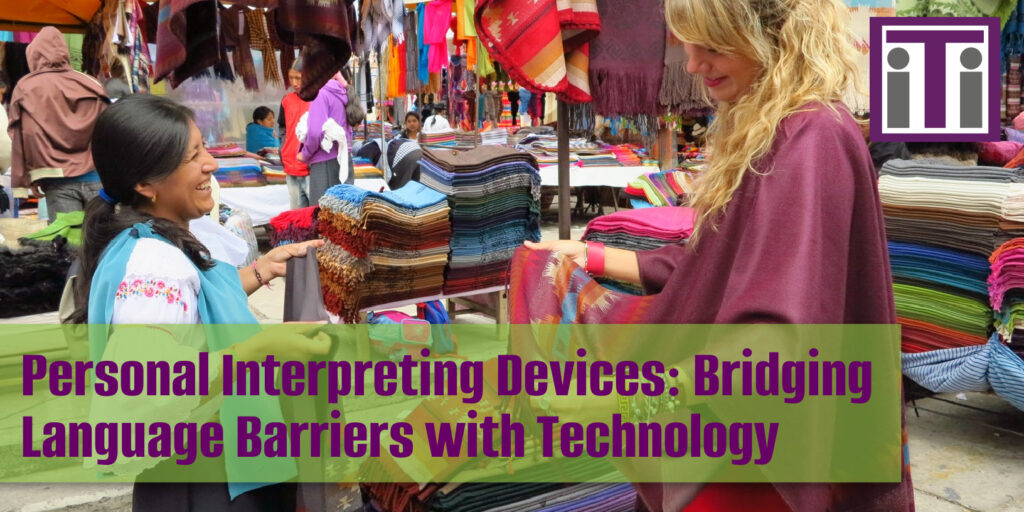Benefits of Educational Interpreter Services
Reading Time: ~8 mins
As the population of the United States continues to grow and diversify, the need to communicate in multiple languages becomes more of a necessity. There are approximately five million students in US schools with limited English language skills that affect their education. Providing services to these students is required by federal law, but that is not the most important reason for providing them.
The most important reason for providing interpreter services to limited English proficient (LEP) students and their families is to ensure they aren’t left behind. In this post, we will discuss the different types of solutions for interpreting in schools. Creating a language access program with the help of a qualified interpreter service company will make all these options available in your school’s community.
Types and Benefits of Educational Interpreter Services
In-Person Interpreting
In this world where so much communication take place online, in-person interpreter services, when practical, are still the most effective solution for breaching communication barriers. Having an educational interpreter in the room is preferred because this provides the best conditions for reading body language and facial expressions, allowing your interpreter to facilitate the conversation in the most effective possible manner.
Dr. Albert Mehrabian is known for his breakdown of human communication into 7% spoken words, 38% tone of voice, and 55% body language. While there is some disagreement on the exact percentages, the consensus is nonverbal communication is extremely critical. This is the main reason why having an interpreter on-site with you is preferred.
Another benefit to working with in-person educational interpreters is it allows teachers and students to build a rapport with the interpreter. Meeting in person provides teachers ample time to brief the interpreter on the situation. Developing a positive relationship will also increase the effectiveness of the interpretation session.
Furthermore, when you find an interpreter that you “click” with, you have more of an opportunity to continue working with them. In-person interpreters help students and their families feel more at ease.
In-person interpreters are available nationwide in a wide variety of spoken languages, including American Sign Language. Whether a deaf or hard-of-hearing student needs an ASL interpreter each day, or Spanish-speaking parents need an interpreter for an upcoming parent-teacher conference, professional interpreting services are there to ensure all students receive an equal opportunity for participation in both education and in the school’s community.
Video Remote Interpreting (VRI)
Video Remote Interpreting has been around for years, but its use grew exponentially in the early days of the pandemic and continues to peak as schools, government agencies and businesses rely more and more on remote communication platforms.
Without VRI, millions of children would have had no way to stay connected to their teachers and classmates. The biggest benefit of VRI is the ability for all parties to see the interpreter and vice versa. This speaks to the importance of non-verbal communication, as discussed above. Another benefit of VRI is that it can be accessed on-demand or pre-scheduled.

Moreover, VRI is convenient. There is no need for travel, and interpreters are typically connected and live on-screen in under 30 seconds.
At iTi, we also offer outstanding security and encryption with our VRI services, which is especially important when communicating with children. We also offer VRI on almost every virtual platform. Here is a helpful resource that covers everything you need to know about VRI.
Over the Phone Interpreting (OPI)
Over-the-phone interpreting is a simple, convenient and cost-effective solution. This service is great for schools that need to call a student’s family to set up meetings such as a parent-teacher conference, psychology review, etc. There is no need to pre-schedule an over-the-phone interpreter. OPI interpreting will be your saving grace in time-sensitive cases.
At iTi, clients need only to set up their telephonic account one time and then they are granted access to interpreters in over 250 languages. You will receive an 800 number and a unique access code, which then connects you with an operator. You are then connected to the interpreter in an average of less than 15 seconds.
The advantage of speaking with a live operator is that you don’t have to navigate automated menus. You can describe the situation, so they can connect you with the best-suited interpreter. At iTi, our operators are familiar with many languages, and can also help if you are unsure of the language for which you need interpretation.
The greatest advantage of OPI is speed. It’s an excellent solution when both parties are communicating over the telephone. However, it is not ideal for every situation.
If the conversation being interpreted is taking place in person, it should be kept in mind that the interpreter cannot see what’s going on in the room and is not always briefed on the circumstances. They have no access to extra-linguistic clues to the speaker’s meaning and context (like body language and facial expressions).
For these reasons, we do not suggest using over-the-phone interpreting for the classroom or important meetings with multiple people in the room; it works best with one-on-one conversations. OPI is a fantastic solution in the right circumstances but it should be used appropriately.
CART (Communication Access Real-time Translation) / C-Print
CART and C-Print aren’t technically interpreter services but they still deserve a mention as they are a fantastic and innovative solution for the classroom. These services are designed for deaf or hard-of-hearing students.
The services are most easily described as subtitles for live discussions. Spoken language is translated instantaneously into text and displayed in various forums such as on a computer or projected onto a screen in the classroom.
A writer can either sit in the classroom with the student or work remotely. This service is extremely popular on a college level and has gained traction in middle and high school as well. For younger children, these services are only effective if the student can read at the level in which the lesson is being given.
- CART creates an exact transcription of the class.
- C-Print summarizes the conversation or lecture. It’s similar to an electronic note-taking system designed to provide a meaning-for-meaning transcription.
CART services are also an innovative solution for graduation ceremonies. While many schools and universities have in-person ASL interpreters attend to interpret for deaf or hard-of-hearing students and families, CART makes a great addition.
Tips For Working With Educational Interpreters

Here are a few tips to prepare for sessions with educational interpreters. Proper preparation ensures that everyone is on the same page for a smooth and successful meeting/class/etc.
- Book your interpreter ahead of time. Whenever possible, give your language services provider background information and any available details of the meeting . This will help them book the best-suited interpreter for your meeting. If you have a particular interpreter you enjoy working with, booking ahead of time will give you a greater probability that they are available.
- Provide reference materials and any background information as necessary. With younger children, alert your language services provider if any sensitive material will be discussed. It’s always best for your interpreters to be as prepared as possible.
- Be prepared for meetings to last about twice as long as usual. Because the interpreter will repeat everything said on both sides of the conversation, timeframes will double. Likewise, prepare the lesson plan accordingly if an interpreter is needed for daily classes.
- Confidentiality. Everything said at the meeting will be interpreted and kept confidential. VRI and OPI interpreting sessions are secure and encryption can be made available.
- Speak to the audience, not the interpreter. Refrain from speaking to the interpreter directly (unless, of course, you have a question for the interpreter). Instead of saying, “Please ask him what his time frame for completion is,” just say, “What is the time frame of completion?” The interpreter will also speak in this manner, not using “He said, “etc.
- Be clear, speak in simple language, and don’t forget to pause. Speak clearly so the interpreter can hear and understand you. Be sure to pause often to give the interpreter time to process what you are saying and find the appropriate equivalent.
We hope you find these tips useful for the next time you work with students with limited English proficiency and or deaf/hard-of-hearing students.
Everyone deserves the right to education, no matter their country of origin. Language service providers such as iTi are here to support you in your goals. Don’t let language barriers frustrate you–overcome them by knowing what services are available and we’ll take care of the rest!
Click below to learn more about how iTi’s translation and interpretation services can work for you. Or check out this related post “How to Create an All Inclusive Education Environment”
| Talk to an Expert |
Interpreters and Translators, Inc. is a full-service language solutions company based in Glastonbury, Connecticut. iTi is an NMSDC-certified minority owned business.






